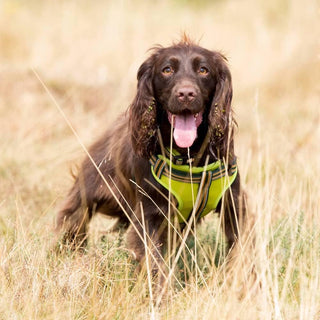Are No-Pull Dog Harnesses Safe? Myths & Facts Explained
Dog owners struggling with leash pulling often turn to no-pull dog harnesses as a solution. These harnesses are designed to reduce pulling and give owners better control, but are they actually safe for your dog? There are many myths and misconceptions about no-pull harnesses, so in this guide, we’ll separate fact from fiction and help you make an informed decision.
If you're looking for high-quality no-pull harnesses, check out the Long Paws Dog Harness Collection for durable and comfortable options.

🔎 What is a No-Pull Dog Harness?
A no-pull harness is a specially designed dog harness that discourages pulling by redirecting your dog’s movement when they try to lunge forward. Unlike traditional back-clip harnesses that may encourage pulling, no-pull harnesses usually feature:
✔ Front-clip attachment (attaching the leash at the front of the chest to redirect pulling)
✔ Even weight distribution (reducing strain on the dog’s neck)
✔ Adjustable straps for a snug and comfortable fit
✔ Padding for extra comfort and safety
No-pull harnesses are popular among dog trainers and pet owners as a gentle, effective alternative to choke chains or prong collars.
🚫 Myths & Misconceptions About No-Pull Harnesses

❌ Myth 1: No-Pull Harnesses Hurt Dogs
✅ Fact: No-pull harnesses are designed to prevent injuries, not cause them.
A well-fitted no-pull harness does not hurt a dog when used correctly. Unlike collars that can put pressure on the trachea, no-pull harnesses distribute force evenly across the chest, reducing the risk of neck strain.
⚠️ Potential Issue: If a harness is too tight, poorly designed, or misused, it may cause chafing or restricted movement. This is why choosing a high-quality dog harness UK and ensuring a proper fit is essential.
❌ Myth 2: No-Pull Harnesses Restrict Shoulder Movement
✅ Fact: A properly fitted harness allows full range of motion.
Some people worry that no-pull harnesses restrict a dog’s shoulders, leading to joint problems. However, this is only true for ill-fitting harnesses.
To ensure natural movement:
✔ Choose a harness that doesn’t sit too high on the shoulders
✔ Opt for designs with ergonomic padding
✔ Make sure it’s not too tight around the chest
Brands like Long Paws offer adjustable, comfortable harnesses that promote full mobility while preventing pulling.
❌ Myth 3: No-Pull Harnesses Are Only for Puppies or Small Dogs
✅ Fact: No-pull harnesses work for dogs of all sizes and breeds.
No matter the size or breed, any dog that pulls on the leash can benefit from a no-pull harness. Large and strong dogs can be especially difficult to manage with a regular collar or back-clip harness, making a front-clip no-pull harness a safer option for both the dog and the owner.
💡 Best for:
✔ Strong pullers (Labradors, Huskies, German Shepherds, etc.)
✔ Excitable breeds (Spaniels, Terriers, Beagles)
✔ Rescue dogs still learning leash manners
❌ Myth 4: No-Pull Harnesses Will Train a Dog to Stop Pulling Forever
✅ Fact: No-pull harnesses are a training tool, not a permanent solution.
While a no-pull harness helps control pulling, it does not replace proper leash training. Over time, consistent training should help your dog learn to walk politely on a leash, reducing the need for a no-pull harness.
🐶 Training Tips:
✔ Use positive reinforcement (reward good walking behavior with treats & praise)
✔ Pair the harness with loose-leash training techniques
✔ Be patient & consistent—good leash manners take time!
❌ Myth 5: No-Pull Harnesses Are Difficult to Put On
✅ Fact: Many modern harnesses are easy to put on and adjust.
Some owners worry that harnesses are complicated and time-consuming to fit. However, brands like Long Paws offer harnesses with quick-release buckles and adjustable straps that make them easy to put on and take off in seconds.
🚀 How to Properly Fit a No-Pull Harness:
1️⃣ Loosen all straps before placing the harness on your dog.
2️⃣ Slide it over your dog's head and adjust the chest strap.
3️⃣ Clip the buckles around the ribcage.
4️⃣ Ensure a snug fit—you should be able to fit two fingers between the harness and your dog's body.
5️⃣ Attach the leash to the front clip for no-pull control.
🛒 Choosing the Best No-Pull Harness for Your Dog
When selecting a no-pull harness, look for:
✔ Front-clip attachment for redirection control
✔ Adjustable straps for a custom fit
✔ Padding for comfort
✔ Durable materials for long-lasting use
✔ Reflective features for nighttime safety
🔥 Check out the best no-pull harnesses at Long Paws for durable, comfortable, and secure designs!
📝 Final Thoughts: Should You Use a No-Pull Harness?
✔ Yes, if your dog pulls excessively on the leash
✔ Yes, if you want a safer alternative to choke chains or prong collars
✔ Yes, if you want better control on walks
❌ No, if you expect it to train your dog without additional leash training
No-pull harnesses are a safe and effective tool when used correctly. They help make walks more enjoyable while ensuring your dog's comfort and safety. However, they should always be paired with consistent leash training for the best long-term results.
🐶 Looking for a high-quality no-pull harness? Explore the best options at Long Paws and make walks stress-free for you and your pup! 🚶♂️🐕
Comments
Post a Comment